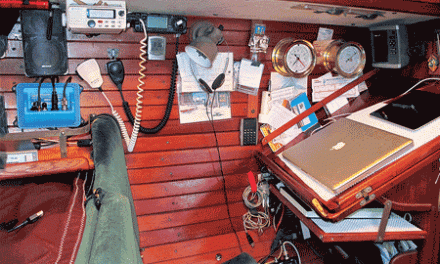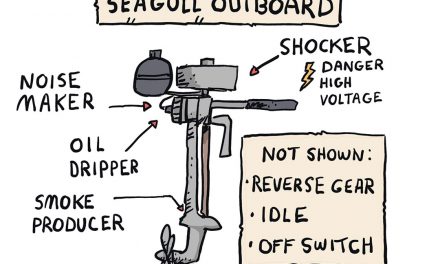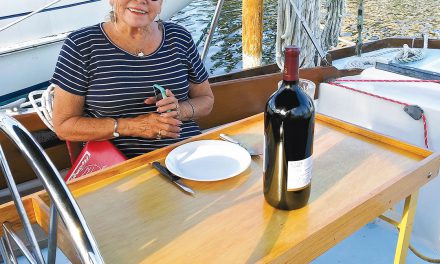Creating an engine water bypass for easy winterization
Issue 152: Sept/Oct 2023
Our 1978 Tartan 27-2, Dawn, has a singlecylinder Farymann engine that is direct-cooled by lake water. The engine has its quirks but has treated us well. As with most boats that sail on Lake Michigan, we need to haul out each fall and winterize the engine to avoid freeze damage.
To winterize, I leave the engine in the haulout well until the last possible moment to ensure the engine is nice and warm. Immediately before the boat is lifted out of the water, I shut everything down and open several small valves on the engine to drain as much water as possible.
Theoretically, I would then remove the engine water hose from the through-hull, place it in a bucket of antifreeze, and run the engine to pump the antifreeze throughout the cooling system as quickly as I can once I’m out of the water. Like many “simple” projects, removing the engine water hose is an exercise in frustration, at best. Most years, I end up rage-cutting the hose, completing my winterization, and leaving it for future Lee to deal with.
Unfortunately, each year the hose gets shorter and shorter, until eventually it must be replaced — at which point I’m stuck taking the flywheel off the engine, removing the water pump, and going through the not-so-enjoyable exercise of replacing the full hose on a mostly uncooperative water pump.

Above, set for normal operation, pulling
water from the lake to the engine.
Below, set for winterization, pulling
water from the bypass (in a bucket of
antifreeze) to the engine.
Accordingly, I started dreaming of a solution that would improve the winterization process and prevent having to reattach hoses each spring. I recalled reading about an approach that involved adding a bypass to the engine water hose to allow for easy winterization. It seemed like a reasonable solution, and I was willing to give it a try.
In preparation, I bought a simple, sturdily built, brass three-way shut-off valve for less than $20 on Amazon. It even came with hose clamps! The valve is shaped like a Y, with valves on both arms of the Y, which allows you to direct water flow in one of two directions. I already had additional hose in the boat project scrap pile that I could use.
Dawn’s engine water through-hull is located beneath the galley sink and is fairly easy to access. I mounted the three-way valve to the side of the cabinet wall with a mounting hook and zip tie. I made sure the valves would either go to the engine or a new length of hose, enabling the option to use either source for water (or antifreeze) passage to the engine. I attached a length of hose from the top of the three-way valve to the engine water pump. Then I attached another length from one end of the valve to the through-hull, and another length from the opposite side of the valve to a long pigtail of hose.
Now, by choosing which valves I open or close, I can either have the engine draw water from the through-hull, or I can place the excess hose in a bucket of antifreeze, open and close the appropriate valves, and easily draw antifreeze from a bucket.
I installed the three-way valve so the valve connections were on the hose leading to the water pump and the bypass hose. I figured I could already control flow from the throughhull via the seacock, so I did not need another valve there. In the future, I will probably rotate these connections so that there is no valve on the hose leading to the engine, but rather, the valve is on the hoses leading to the bypass and the seacock. Ultimately, I have been unable to determine a circumstance in which I would want to shut off flow entirely to the engine, so a valve is not needed on that connection.
Last fall, I was able to use this approach when winterizing the engine, and it worked beautifully. There was no rage-cutting of hoses or scraping of elbows to reattach a short hose to the through-hull, only amazement at how well a job I had done. And for less than $20 in materials and 30 minutes of work, future Lee is now thankful for past Lee, rather than cursing his name. I’ll buy myself a beer for that.
Lee Mueller and Traci Montgomery sail their 1978 Tartan 27-2, Dawn, out of Whitehall, Michigan. Over the last six seasons, they’ve been slowly restoring and improving her. Each summer, they can be found sailing around Lake Michigan. Their projects can be followed on Instagram at @ SV_Dawn.
Thank you to Sailrite Enterprises, Inc., for providing free access to back issues of Good Old Boat through intellectual property rights. Sailrite.com





